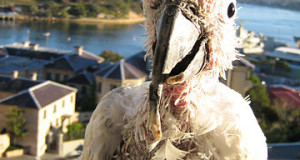Looking much like out-sized crows, to which they are related, Common Ravens are  considered by many ornithologists (biologists who study birds) to be the most intelligent of the world’s 9,000+ bird species. People have apparently held this view from the earliest of times, as the folktales and legends of many races are filled with tales attributing great powers and cunning ways to these impressive birds.
considered by many ornithologists (biologists who study birds) to be the most intelligent of the world’s 9,000+ bird species. People have apparently held this view from the earliest of times, as the folktales and legends of many races are filled with tales attributing great powers and cunning ways to these impressive birds.
We now have many indications of just how smart birds can be – a number use tools, and some have adjusted to changing conditions and have passed along their newly-acquired knowledge to other birds (more on that in future articles, but please write in if you’d like details). And, of course, parrot owners can fill volumes with tales of their birds’ learning abilities.
One of the most startling observations I’ve run across involved Ravens. One winter not long ago, people ice-fishing in northern Europe (I believe it was in Finland) began to find their hooks, devoid of bait and fish, lying on the ice near the hole that had been cut to allow access to the water below (fishing on an ice-covered lake during Finland’s winter is a cold business to say the least, so the lines were left untended while the fisherman wisely defrosted in nearby huts).
At first, neighboring fishermen were blamed, but some spying uncovered the real culprits. Ravens, apparently after watching people bait their hooks, learned to lift the lines with their beaks.
Keep in mind first that the birds had to associate the end of the line, now well below water, with food. The lines were quite long but, amazingly, the Ravens learned to stand on the slack each time it was laid down on the ice, so that it would not slide back into the water – and they figured this all out in the time that people were warming up and not watching!
The bait-thieves were likely helped in their efforts by the cooperative bond that develops between paired Ravens. Those observing the birds noted that one always kept watch while the other hauled up the line. As Ravens sometimes feed together, without posting a sentry, one is tempted to wonder – did they “know” to expect trouble?!
I once kept an injured Fish Crow (Corvus ossifragus), relative of the Raven, for a time. The bird took all of 20 minutes to learn how to open the latch on his cage’s door. Once I secured the latch with a lock, he would check the lock (once only) by rattling it, and no longer bothered with the latch itself. When I purposely left the lock unfastened, he immediately flipped it off and then lifted the latch.
Parrot owners are always great resources when it comes to “smart bird” stories.
You can learn a great deal about Raven natural history at:
http://www.birds.cornell.edu/AllAboutBirds/BirdGuide/Common_Raven_dtl.html
Image referenced from Wikipedia, uploaded by Franco Atirador in Feb. 2007, and using the GNU Free Documentation License. http://en.wikipedia.org/wiki/Image:Raven_croak.jpg
 That Bird Blog – Bird Care and History for Pet Birds
That Bird Blog – Bird Care and History for Pet Birds




Thanks for this nice article on the intelligence of Ravens! I have always loved ravens and have seen how intelligent (and social) they really are. I have a flock of them in the pines right outside of my house and today something is going on because they are flying low, hopping around, and screeching their heads off! I was wondering if this might be the time the babies leave their nest??? (it’s May 25th… in Central Maine) One of them just walks around my driveway and the others follow either from up in the trees, and at then they land next to him and walk with him (but they are definitely telling him to do something! LOL). I don’t think he’s injured as he does fly a little, but doesn’t go very high. I think he might have fallen out of the next just a few days before he should have. What’s amazing is that the whole “raven community” that lives in my woods is keeping watch over him and it’s wonderful to watch them all.
Hello, Frank Indiviglio here.
Thanks for your interest in our blog and the kind words, much appreciated.
It could be as you say, a youngster out of the nest …timing varies a bit with the weather in late winter/early spring; this seems a bit early but not out of the question. They fledge at adult size so no way to tell other than behavior, etc. Even if they fledge on time, young ravens are poor fliers at first and are followed about by the adults, fed and protected, for a time. I don’t get to see them here near NYC, must be nice to have them so close,
Enjoy and please keep me posted.
Best regards, Frank Indiviglio.